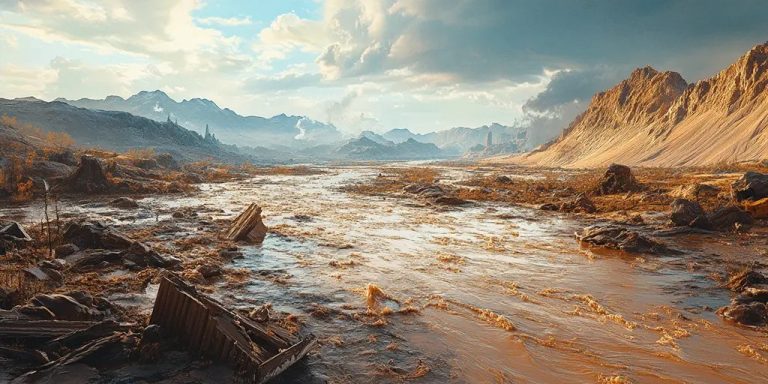From Dr. Roy Spencer's Global Warming Blog
Author: Dr. Roy W. Spencer
The recent devastating flooding in western North Carolina is not unprecedented, but it is certainly rare. A recent master's thesis studied flood sediments along France's Broad River over the past 250-300 years and found that a flood in 1769 produced water levels about as high as those reported from recent flooding caused by Hurricane Helene. So, yes, the flood was historic.
As with all severe weather events, it takes a confluence of contributing factors for an event to become “severe,” such as those that caused flooding in North Carolina. In this case, to produce widespread 12-20 inches of rainfall would require a strong hurricane combined with a steering flow that would bring the hurricane on a track that would produce the greatest amount of orographic uplift on the east side of the Great Smoky Mountains. And the steering flow must be so strong that the hurricane can penetrate far inland with little weakening.
Likewise, all severe weather events represent some random combination of amplified ingredients: in the case of Hurricane Helene, they produced unfortunate massive flooding outcomes not seen in the region for hundreds of years.
Random component of precipitation variability
When one examines many events, statistics can be used to test for rare superpositions of several rare influencing factors, or for more common superpositions of more common factors. For example, it is known that precipitation statistics collected over many years exhibit a lognormal frequency distribution. In short, the lowest precipitation occurs most frequently and the highest precipitation occurs least frequently. This is a statistical summation of factors such as (in the case of excessive rainfall) adequate humidity, unstable air masses, low-level air convergence, stationary or slow-moving storms (in western North Carolina, mountains providing lift is stationary) etc.
Extreme precipitation events are (of course) the rarest, so they can exhibit some strange behavior. This is why hydrologists disagree on the usefulness of the term “100-year flood,” since most weather records don't even extend beyond 100 years. One would probably need 1,000 years of rainfall records to get a good estimate of the composition of the 100-year event.
Statistically modeling extreme rainfall events
It is easy to produce a simulated time series of rainfall totals with a lognormal distribution in Excel. For example, the chart below shows hypothetical daily totals from 1900 to 2024, showing that the occurrence of maximum rainfall days (red circles) appears to be increasing. Could this be climate change?

But remember, these are randomly generated numbers. Just like when you toss a coin and sometimes get 4 heads (or 4 tails) in a row, it doesn't mean there is some underlying reason why you get the same result several times in a row. If we extend the above graph from 125 to 500 years, we see (below) that there is no long-term increasing trend in heavy rainfall:

black swan event
Or how about I call it “The Great Flood of August 28, 2022”?

Note that this event (generated using only lognormal distribution random numbers) far exceeds any other daily event in this 500-year plot.
The point here is that we often tend to attribute severe weather events to some underlying cause that emerges over time, such as global warming. And, I believe that some of the changes we are seeing in nature are due to the (weak and largely benign) warming trend that most of the world has experienced over the past 100 years.
But the occurrence of these events may not lead to any potential long-term changes in the climate system. It would be foolish to attribute every change we see to global warming, especially when it comes to precipitation-related events such as floods… or even droughts.
'Random drought'
Now changing our daily stochastic lognormal precipitation generator to a monthly time scale, we can see how precipitation changes from decade to decade. Why monthly? Well, weather changes (and even climate cycles) tend to have preferred time scales. This is several days for weather patterns, quasi-monthly for some types of sustained weather patterns, and even annual or decade-long for some natural internal climate cycles.
When I generate a stochastic lognormal time series on a monthly time scale and calculate the decadal average over the past 120 years, the long-term trend is rarely close to zero. Here's how low precipitation has been over the past three decades, which is purely accidental:

This looks like something we can attribute to the drought in California, right? However, this is just the result of random numbers.
Alternatively, we can choose one of the random simulations with an increasing trend:

I'm sure someone can relate this to global warming.
Summary of the 100-year flood event
There seems to be some misunderstanding about the 100-year event. These are almost always applicable to specific locations. Therefore, the United States holds 100th anniversary commemorations every year, as long as they are in different locations, there is nothing unusual. Western North Carolina will experience a 100-year flood this year, and eastern North Carolina may experience a 100-year flood next year. That doesn't mean 100-year floods will become more frequent.
I'm not saying that all severe weather is the result of randomness. There's just a huge random component that makes attributing any type of severe weather event to climate change essentially impossible.
Relevant
